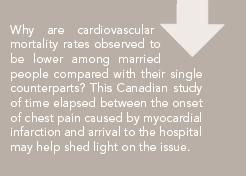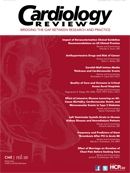Effect of Marriage on Duration of Chest Pain Before Seeking Care


Jam es P. Eichelberger, MD, FACC
REVIEW
Atzema CL, Austin PC, Huynh T, et al. Effect of marriage on duration of chest pain associated with myocardial infarction before seeking care. CMAJ. 2011. doi:10.1503/cmaj.110170.
M
arriage certainly has some benefits. A recent article published in the Canadian Medical Association Journal1 provides interesting insight that may help explain the observed lower cardiovascular mortality rates among married people compared with their single counterparts.
Study Details
This retrospective analysis evaluated 4,403 patients who presented to 82 hospitals in Ontario, Canada, during a 1-year period between April 2004 and March 2005 with symptoms of chest discomfort due to acute myocardial infarction (MI). The investigators hypothesized that being married is associated with less time delay from symptom onset to hospital arrival, and that this effect would be more pronounced in married men compared with married women. All data were abstracted from hospital records by trained nursing personnel and MIs were verified by positive cardiac enzymes.
The primary analysis compared patients who presented more than 6 hours after onset of chest pain with those who presented after less than 6 hours, consistent with previous literature and the significant incremental myocardial salvage obtained through urgent revascularization within this time period. Marital status was characterized as single, married, divorced or separated, or widowed. Attempts were made to assess for potential confounders including age, clinical features, living arrangement, ethnic origin, socioeconomic status, mode of transportation, arrival time, and arrival day. Multivariable logistic regression modeling was used to determine an independent effect of marital status on delayed presentation.
The mean age of patients was 67 years; 34% were women. The overall 30-day mortality rate was 6.9%. Discrete times from chest pain onset to hospital arrival were available for 87% of patients. The adjusted odds ratio (OR) of a delayed presentation greater than 6 hours after chest pain onset were lower for married patients compared with single patients (OR, 0.46; 95% CI, 0.30-0.71, P <0.001). A separate analysis of men and women concluded that there is a significant relationship between being married and early presentation for men (OR, 0.35; 95% CI, 0.21-0.59, P <0.001) but not for married women (OR, 1.36; 95% CI, 0.49- 3.73, P = 0.55).
Several other factors were determined to be associated with a reduced likelihood of delay in presentation. For men these included nighttime presentation (midnight to 8 a.m.), South Asian ethnicity, being separated or divorced, and calling an ambulance. For women, calling an ambulance and higher income level were associated with a reduced likelihood of delay, but being divorced (as opposed to single) and having a documented history of depression were associated with an increased likelihood of delay in presentation. Older age was associated with an increased likelihood of delay in presentation in both men and women. Of all the factors evaluated, calling an ambulance had the greatest effect on the primary outcome.
For all patients the reduced likelihood of presenting late when married compared with being single was significant at all time periods assessed (>2, >6, or >12 hours of delay), but this relationship was not significant when the analysis was restricted to women only. Interestingly, of the subgroup of patients in whom discrete time duration between symptom onset and presentation was known, only a trend toward shorter time to presentation among married people was identified (30 minutes less; CI, 63 minutes less to 2 minutes more). Of equal interest is that “living with someone” was associated with a significant increase in delay to presentation (OR, 1.47; CI, 1.06-2.04, P = 0.02) that was not present in the subgroup analysis of patients who had a discrete time from pain onset to presentation.
he authors conclude that in the setting of acute chest discomfort due to MI, earlier presentation is seen in married people and that effect is more pronounced in married men compared with married women. They also conclude that earlier presentation in married men is one explanation for the observed lower risk of cardiovascular death in this group compared with single men. The authors further conjecture that women may be more likely than men to be caregivers because they advise their husbands to seek early medical assessment. Study limitations inherent in a retrospective design were acknowledged.
References
1. Atzema CL, Austin PC, Huynh T, et al. Effect of marriage on duration of chest pain associated with myocardial infarction before seeking care. CMAJ. doi:10.1503/ cmaj.110170.
2. Canto JG, Goldberg RJ, Hand MM, et al. Symptom presentation of women with acute coronary syndromes: myth vs reality. Arch Intern Med. 2007:167:2405-2413.
3. McSweeney JC, Cody M, O’Sullivan P, Elberson K, Moser DK, Garvin BJ. Women’s early warning symptoms of acute myocardial infarction. Circulation. 2003;108:2619— 2623.
4. Macleod U, Mitchell ED, Burgess C, Macdonald S, Ramirez AJ. Risk factors for delayed presentation and referral of symptomatic cancer: evidence for common cancers. Br J Cancer. 2009;101:S92-S101.
5. Ting HH, Bradley EH, Wang Y, et al. Factors associated with longer time from symptom onset to hospital presentation for patients with ST-elevation myocardial infarction. Arch Intern Med. 2008;168:959.
6. King KB, Reis HT. Marriage and longterm survival after coronary artery bypass grafting Health Psychol. [published online ahead of print August 22,2011]
7. Burgoa M, Regidor E, Rodriguez C, Gutierrez- Fisac JL, et. al. Mortality by cause of death and marital status in Spain. Eur J Pub Health. 1998; 8:37-42.
COMMENTARY
Marital Status and Health Effects
W
hile this study demonstrates a statistically significant earlier presentation during chest discomfort due to MI among married people (primarily married men) compared with single people, these results should be interpreted with caution. First, the authors reason that time delays due to atypical presentations in women have been minimized by including only patients presenting with chest discomfort. However, the character of chest discomfort was not evaluated in this study and is often the very essence of what defines an atypical presentation. Women present with higher percentages of indigestion symptoms, neck discomfort, and jaw discomfort compared with their male counterparts.2,3 Any of these symptoms may be generalized and loosely referred to as “chest” discomfort in a medical record being retrospectively reviewed.
Second, the ability to document and control for potential confounders was limited. For example, ethnicity may have a strong association with delay to presentation but was not consistently recorded and was only analyzed for two overlapping ethnic backgrounds (Chinese and South Asian). Ethnicity has been shown to be a strong predictor in delayed presentation of other conditions such as cancer.4 In one recent study, being black and/or Hispanic (both groups have a significant presence in Ontario, Canada) were strongly associated with delay to presentation with ST elevation MI.5
A diagnosis of depression, another potential confounder, was based only on its appearance in the medical record reviewed. The authors acknowledge that distance required to travel to a hospital, another potential confounder, was not evaluable in this retrospective analysis. Time of day was determined to be significantly associated with time delay of presentation, so other potential related confounders such as weather or traffic that could not be assessed may have also had an effect.
Third, the results are statistically significant only when compared with patients who are single and not to patients who have been divorced, separated, or widowed. If a caretaker effect were responsible for the decrease in time to presentation among married men compared with those who are single, as the authors conjecture, then why wouldn’t there be a difference between married men and other groups evaluated? These results raise the possibility that satisfaction within a status (happily divorced, unhappily married, as examples) may be important influences. Indeed, separated or divorced men had a statistically significant earlier presentation in this study.
One recent study demonstrated significantly improved cardiac outcomes in happily married patients compared with those who reported low marital satisfaction.6 Other studies have shown that divorced and separated persons have a lower mortality from cardiovascular and cerebrovascular disease compared with married persons, implying a more complex relationship between marital status and health effects than is stated in this article.7
Finally, the results show some inconsistencies. On one hand, married men have an earlier presentation compared with single people, but opposite results were demonstrated for those living with someone—where a longer time to presentation was found compared with living alone (P = 0.023). Certainly most married men would also be correctly categorized as living with someone. Also, in analyzing the large subgroup (3,967 patients) with a known discrete time between symptom onset and presentation, the association between marital status and earlier time of presentation no longer reached statistical significance. One would expect that if an association existed, it would have been strengthened by a group with more accurate determination of time between symptom onset and presentation as compared with a cohort that included estimates of that same interval.
In summary, this analysis by Atzema et al adds some information to the relationship between marriage and delay in presentation with chest discomfort due to MI, but lack of symptom characterization and lack of ability to adequately control for potential confounders inherent in a retrospective study design likely contributes to inconsistencies in the results and limits the applicability of the findings. Information from this study underscores the complexity of properly evaluating the effects of marriage on any health condition. Furthermore, to surmise that we may understand the reason behind the shaky marital differences identified, such as a “spouse encouraging earlier pursuit of medical care” or “wives more likely than husbands to assume the caregiver role” is a wild guess at best and approaching discrimination at worse.
About the Author
James P. Eichelberger, MD, FACC, is Associate Professor of Medicine, Cardiology Division, at the University of Rochester Medical Center, Rochester, NY, Program Director of the Adult Cardiovascular Fellowship, a member of the Medical Student Admission Committee, Co-Director of the Adult Congenital Heart Disease Program, Director of Outpatient Cardiology, Clinton Crossings, and an attending physician at Strong Memorial Hospital. Dr Eichelberger received his MD from the University of Rochester School of Medicine and completed his Residency at University of Vermont Medical Center and Fellowship at the University of Rochester Medical Center.
